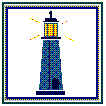 |
Warning of Danger |
 |
Lighthouses have protected sailors from danger and guided ships into safe harbors for thousands of years. The Lighthouse of Alexandria, located on the ancient island of Pharos, Egypt, is one of the earliest lighthouses on record, being built about 2,000 years ago. It was also one of the Seven Wonders of the Ancient World. The first lighthouses had fires burning from the top of stone towers to warn sailors of craggy shoes, sandbars, hidden points of land, or shallow spots. Lighting the Way Visibility was a problem for early sailors, coal and wood fires could not be seen far out to sea. Mariners complained, "What good is a warning light if you can't see it?" By the 1600's tallow candles fueled by whale or fish oil gave some improvement, but not much,. In 1763, reflectors, like the shiny shield behind your flashlight bulb, were added to the lighthouse in Liverpool, England. This increased even farther the length of the light beam, but ships continued to wreck off the rocky coasts. In 1821, the French government commissioned a young engineer, Augustin Fresnel, to design a system that would greatly increase the visibility of the lighthouse beam. He did. His invention was a curtain of prisms in front of the light source and centered around a bull's-eye lens. The light rays were refracted, or bent, and focused into a horizontal beam. Reflecting prisms above and below the light source gathered normally wasted light rays to add to the total illumination. The Fresnel lens is used in most lighthouses today. The largest Fresnel lens was placed in the Cape Hatteras Lighthouse in 1870. It measured 12 feet in height and 6 feet in diameter. Impressive segments of it are in the lighthouse museum. Today, two modern 1,000-watt airport beacons sit atop the Cape Hatteras Lighthouse, giving mariners visibility from 20 miles away. Patterns of Light Sailors needed a way to know the source of a given light. If they knew the light was coming from Old Matinicus Rock Lighthouse in Maine, or Thatcher's Island Lighthouse in Massachusetts, they could look at their map and know what danger points were near. For this reason, each lighthouse has its distinctive design or color pattern and a distinctive light patter, called its characteristic. Along the Cape Hatteras National Seashore, there are three lighthouses. The Bodie Island light sends two white flashes every 22 seconds. The Ocracoke Island light sheds a constant white light. Both lighthouses have Fresnel lenses. The beam at Cape Hatteras sends one white flash every 7.5 seconds. Seeing the pattern, seafarers can check a light list to identify their position. You Are Light Jesus said, "You are the light of the world" (Matthew 5:14). In many ways my parents were like a lighthouse beacon. My two brothers,sister, and myself could count on them being there for us as a sailor can count on the lighthouse beam. Mom and Dad warned us of dangers: unsafe people, unsafe places, and bad habits. They helped us chart a path that would help us reach our goals. Like sailors on life's sea, we have to row our own boat, but our parents guided us and encouraged us. Their faith helped us see God more clearly. Their faithful love showed us how to be faithful. Their self-sacrifice taught us how to give to others. They were consistent. They didn't just talk about what they thought was right. They lived what they preached. In storms or calm, they were there for us. They cheered us on when waters were smooth, when we won games or awards. They were there to rescue us when we messed up, or to bind our wounds when we were beaten down. Our parents were God's light to us. Jesus challenges us to be that kind of light for others. Who is light for you? For whom are you that faithful light?
| Ascent Foundation Homepage | Human Rights Index |
Thanks For
Visiting, Please Come Again!
~ Ascent
Foundation ~